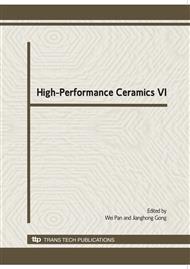p.796
p.799
p.803
p.805
p.808
p.814
p.816
p.820
p.823
Finite Element Modeling of Temperature Distribution in Spark Plasma Sintering
Abstract:
A finite element model (FEM) is developed to simulate the temperature distribution in the sample/die/punch assembly during the spark plasma sintering (SPS) process. A thermal–electrical coupled model with temperature dependent thermal and electrical properties is implemented. The simulation studies were conducted using COMSOL and a range of heating-rates and die sizes were considered. Also, both temporary and equilibrium condition during heating process were evaluated in order to express the real temperature development in the sintering. During the spark plasma sintering process, the temperature difference between the sample center and the die surface depend on the heating-rate and die size. The simulation results also revealed that the temperature gradient during the heating process is much bigger than that in the dwelling period. It is necessary to consider the temporary state during the spark plasma sintering process in order to guarantee a well–controlled microstructure, especially in non-conductive ceramic materials.
Info:
Periodical:
Pages:
808-813
Citation:
Online since:
March 2010
Authors:
Price:
Сopyright:
© 2010 Trans Tech Publications Ltd. All Rights Reserved
Share:
Citation:


